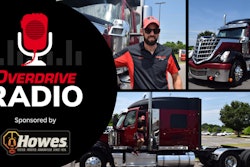Safe merging requires alertness, patience and courtesy.
Let’s be upfront about this: Though merging can seem second nature to an experienced operator, it’s one of the most challenging maneuvers you face on the open road, and the difficulty factor jumps in congested areas.
“Merging is one of the biggest problem areas you have to be aware of all the time you’re driving,” says Shawn Cavanaugh, 49, an owner-operator leased to Camel Express. “You have to be aware from when you’re going 3 mph coming in and out of toll-booth stops to 65 mph traveling down the interstate.”
Merging without incident requires constant vigilance, patience and courtesy. Heavy traffic, frustrated drivers and changing road conditions make merging difficult, if not dangerous, veteran operators say. Though there’s no guarantee the four-wheeler next to you won’t do something stupid, keeping the following tips high in your mind the next time you change lanes might help you avoid the worst-case scenario.
Check your mirrors
“Biggest problem with merging and lane changing is you have to be extremely careful of people coming along on your right side,” says Randy Miller, 59, a Harris Trucking driver from Bristol, Tenn. “I don’t think people do it intentionally or because they are rude – it’s just that they’re in such a hurry. The road can be clear one second, and the next there is a car beside your trailer.”

Miller says mirrors are one of the most important pieces of equipment on your truck. He has three mirrors on the right side of his tractor and two on the left side, including one mounted on the door that focuses on a blind spot on the side of the tractor. “Check your mirrors every 10 seconds, 20 seconds,” Miller says.
Cavanaugh bought a new truck earlier this year and added optional mirrors that he can move both up and down and side to side. “They are extremely beneficial in helping me find cars in my blind spots, especially if a car is coming alongside of me in a toll-booth area,” says Cavanaugh, of Shamokin, Pa.
“There are always going to be blind spots, no matter what truck you drive,” says Gene Vick, 46, a driver for Wild West Express from Las Cruces, N.M. “The worst blind spots are when a car is right beside me at my drive tires. You really have to watch.
“I have two big mirrors and two spot mirrors, and I’m checking them all the time. Make sure your mirrors and windows are clean.”
Watch your speed
Controlling your speed is critical when merging in heavy traffic – as well as being an important tactic in increasing fuel mileage. Experienced drivers recommend driving the speed of traffic in your lane or a little slower. Miller says he runs four to five miles per hour under the speed limit, which he says makes little difference in when he arrives at his destinations.
“If you’re on the freeway, you need to slow down and let merging traffic get in front of you or move over to a left-hand lane if possible,” Vick says. “I try to observe the posted speed limit. It depends on where you’re driving. In California, the speed limit is a lot slower than the speed cars are driving, and the truck speed limit is less than for cars.”
Miller says, “If I’m in the outside lane and cars are entering, I try to lay off the accelerator and give them plenty of room. I never try to crowd or intimidate anybody. The worst mistake anyone can make is trying to intimidate another driver.”
Planning ahead and allowing extra time to reach your destination is a vital part of limiting your speed. Cavanaugh says he sees many truck operators drive too fast and tailgate because they are in a rush.
“I try to build as much extra time in my trip as I can physically put in,” Cavanaugh says. “I do things like get across a bridge at a less congested time or drive through an area when the traffic is less busy. When you hurry, your guard goes down.”
Signal your intentions
It almost goes without saying, but using your turn signal makes merging easier. Some drivers may speed up to get around you when they see your signal, but at least they know what your intentions are. Once the last vehicle passes your mirror, you can begin changing lanes. Keep the signal on until you complete your move.
“If I’m in a big city, I try to stay in the second or middle lane until I get close to my exit,” Vick says. “I signal and start getting over a mile or half-mile from my exit.”
Keep your distance
Virgil Stilwell, 59, of Roanoke, Va., says he eyes on-ramps and will often slow to let merging traffic ahead of him to avoid problems. Stilwell, who also drives for Harris Trucking, is especially wary of merging vehicles that cross in front of him to get to an inside lane.
Tailgating is a common cause of accidents and makes merging and driving in heavily trafficked areas more troublesome. Miller, who trained other drivers for six years, believes in maintaining a long minimum distance from traffic in front of him.
“I try to maintain two-and-a-half to three tractor-trailer lengths between me and the vehicle in front of me,” Miller says. “That’s hard to do in the Northeast, because someone will jump in that space and take away that distance. Just take your foot off the accelerator for a couple of seconds, and you can get your distance back.”
Stilwell says a safe following distance is seven seconds, or seven truck lengths. “You have to adjust according to the roads you’re traveling on,” depending on things like the number of off- and on-ramps in a given space, he says. “Pay attention to your braking distance, weather conditions, the type of traffic you’re following.”
When he can, Vick aims to stay the length of a tractor-trailer behind the truck in front of him, but heavy traffic makes this more difficult. That makes it important to constantly monitor your CB radio and local traffic reports to keep up with traffic delays, he says.
Choose your lane wisely
Your lane of travel makes a difference, veteran drivers say. But there’s no consensus on which lane is best.
Cavanaugh tries to drive in the outside lane. “Because I travel at a slower speed for better fuel economy, I usually drive in the right lane,” he says. “I don’t have a problem with trucks passing me.”
Vick says he prefers the right-hand lane, especially if traffic is slow or stopped. “That way you can always hit the shoulder,” he says.
Miller, on the other hand, prefers the middle lane or the second lane from the right. His reasoning: In that lane, he encounters less merging traffic.
“I try to stay out of the far-right lane because of merging traffic and traffic leaving the freeway,” Miller says. “People are so preoccupied, you have to watch every move they make.”
Stilwell also spends most of his time in the second-from-the-outside lane to avoid merging traffic. “In the outside lane, you’re asking for trouble,” he says.
In heavy traffic, he says he will signal and make his move to the outside lane up to a mile and a half from his exit.
Words of Wisdom From the Trainer
Randy Miller was a trainer for new drivers at Harris Trucking in Roanoke, Va., for six years. His prescription for driving in congested areas was simple: Stay alert and keep distractions to a minimum.
“I told them about maintaining a steady rate of speed,” he says. “Keep your truck in your lane and don’t switch from lane to lane. And always use turn signals.” He told trainees not to use cell phones and not to read maps or electronic devices when behind the wheel.
“Before going to an area that’s not familiar, get good directions from your dispatcher or your customer,” Miller says. “If you’re on a CB asking for directions when you’re in an area, it’s already too late. If you’re driving on an unfamiliar road, slow down and try to anticipate where your exit ramp will be. Get in the far right two lanes so you have fewer lanes to cross to get to your exit. If you go past the exit, don’t try to stop and back up.”








